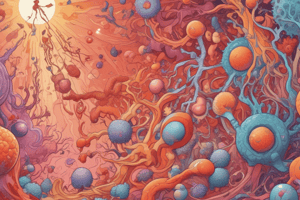Podcast
Questions and Answers
Which of the following statements accurately describes the role of macrophages in the spleen?
Which of the following statements accurately describes the role of macrophages in the spleen?
- Macrophages in the spleen play a crucial role in removing old and damaged red blood cells from circulation. (correct)
- Macrophages in the spleen primarily filter lymph fluid, removing foreign particles and pathogens.
- Macrophages in the spleen are primarily involved in the synthesis of antibodies to fight infections.
- Macrophages in the spleen are responsible for the production of red blood cells.
Which of the following cells are analogous to Kupffer cells in the liver, residing in the spleen and performing a similar function?
Which of the following cells are analogous to Kupffer cells in the liver, residing in the spleen and performing a similar function?
- Lymphocytes
- Neutrophils
- Splenic macrophages (correct)
- Mast cells
Which of the following statements accurately reflects the primary function of alveolar macrophages in the lungs?
Which of the following statements accurately reflects the primary function of alveolar macrophages in the lungs?
- Alveolar macrophages primarily function in the transport of oxygen from the alveoli to the bloodstream.
- Alveolar macrophages play a critical role in engulfing and destroying inhaled pathogens and debris. (correct)
- Alveolar macrophages are responsible for the production of surfactant, a substance that reduces surface tension in the alveoli.
- Alveolar macrophages are primarily involved in the contraction and relaxation of the smooth muscle in the bronchioles.
Which of the following is NOT a characteristic of the process of phagocytosis?
Which of the following is NOT a characteristic of the process of phagocytosis?
Which of the following statements accurately describes the response of macrophages to infection?
Which of the following statements accurately describes the response of macrophages to infection?
Which of the following is NOT a characteristic of lymph nodes?
Which of the following is NOT a characteristic of lymph nodes?
Which of the following statements accurately describes the role of the lymphatic system in immune defense?
Which of the following statements accurately describes the role of the lymphatic system in immune defense?
Which of the following statements accurately describes the role of neutrophils in the inflammatory response?
Which of the following statements accurately describes the role of neutrophils in the inflammatory response?
Which of the following statements accurately describes the role of bradykinin in the inflammatory response?
Which of the following statements accurately describes the role of bradykinin in the inflammatory response?
Which of the following statements accurately describes the role of histamine in the inflammatory response?
Which of the following statements accurately describes the role of histamine in the inflammatory response?
Flashcards are hidden until you start studying
Study Notes
Inflammation and Defense
- Within minutes of inflammation, macrophages in tissues begin phagocytic actions and become mobile in response to chemotactic factors.
- Sessile macrophages break loose from their attachments and migrate to the inflamed area, contributing to the defense.
- Large numbers of neutrophils invade the inflamed area within the first hour, attracted by products in the tissue that cause chemotaxis.
Neutrophil Invasion
- The number of neutrophils increases by four-to fivefold within a few hours after the onset of severe acute inflammation.
- Neutrophilia is caused by inflammatory products that mobilize neutrophils from the bone marrow into the circulating blood.
Macrophage Invasion
- Monocytes from the blood enter the inflamed tissue and enlarge to become macrophages, providing a third line of defense.
- The buildup of macrophages in inflamed tissue is slower than that of neutrophils, but they become the dominant phagocytic cell after several days to several weeks.
Fourth Line of Defense
- The bone marrow greatly increases production of both granulocytes and monocytes, stimulated by granulocytic and monocytic progenitor cells.
- Myeloperoxidase, a lysosomal enzyme, catalyzes the reaction between H2O2 and chloride ions to form hypochlorite, which is exceedingly bactericidal.
Monocyte-Macrophage Cell System
- The reticuloendothelial system (monocyte-macrophage system) consists of monocytes, mobile macrophages, fixed tissue macrophages, and specialized endothelial cells in the bone marrow, spleen, and lymph nodes.
- Fixed tissue macrophages can break away from their attachments and become mobile macrophages when appropriately stimulated.
Tissue Macrophages
- Tissue macrophages in the skin and subcutaneous tissues (histiocytes) can divide in situ and form more macrophages when infection begins.
- Macrophages in lymph nodes trap foreign particles that enter the tissues, such as bacteria, in a meshwork of sinuses.
- The spleen is similar to lymph nodes, with blood flowing through the tissue spaces of the spleen and macrophages lining the trabecular meshwork of the red pulp and venous sinuses.
Inflammation
- Tissue injury releases multiple substances that cause secondary changes in the tissue, including increased local blood flow and capillary permeability.
- Inflammation causes "walling off" the area of injury from the remaining tissues, delaying the spread of bacteria or toxic products.
- The intensity of the inflammatory process is usually proportional to the degree of tissue injury.
Studying That Suits You
Use AI to generate personalized quizzes and flashcards to suit your learning preferences.




